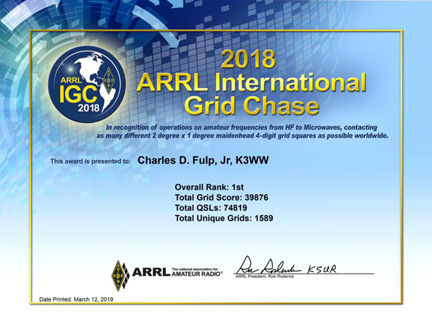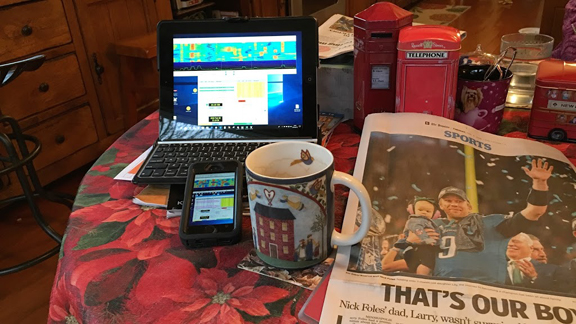I operated seriously in the ARRL INTERNATIONAL GRID CHASE in 2018



These are my monthly QSO totals per mode the QSL count has gone up with late LOTW verifications that did not count for the GRID total at tht time. The 5170 hours represent hours in which at least one QSO was made, not total time on the air. I was trying to make more CW contacts than FT8, although FT8 was the most productive for confirming new grids each month. 126,519 is by far the most QSOs I have made in a single year.

The ARRL International Grid Chase was announced in late 2017, and on my initial reading, it seemed like something that would fit my operating schedule. I usually spend a fair amount of time contesting most weekends. Late in 2017 I discovered that, for me, FT8 was fun. It seemed with my usual weekend activity and a little FT8 during the week I could work a lot of grids. I did not pay much attention to the details, as my approach was to work everyone possible on every band and mode and let LOTW sort out the details. Late October thru early March is known as the “Contest Season” in the Frankford Radio club. We concentrate on CQWW and ARRL DX but in between are Sweepstakes and 3 or 4 160 meter events, and the 10 meter contest. I concentrated on my normal schedule through the ARRL DX SSB test in March. By March it became apparent that chasing all grids on all bands and modes was not the goal. The “grid scores” start at 0 each month, but there is a running total grid score and a running UNIQUE GRID score which is not band or mode related. My strategy of working everyone, everywhere was not correct. It was obvious folks that were almost exclusively FT8 were hanging in in the Grid Score and excelling in the Unique Grids area. By March I was doing well enough in the standings to start thinking of strategic changes. WPX SSB is after our contest season and I usually enter casually or QRP, this year I went high power, full time and since I had worked lots of Europe in ARRL DX SSB, I concentrated on working US grids on as many bands as possible. Since March many of the contests in which I have participated are no longer competitions but operating events where I target regions and bands where I am most likely to pick up new grids. I was aware of JT Alert; however, it did not appear to fit into my station layout, and during the Contest Season, I don’t like to change my setup much. I began the year using a stand alone IC7300 for FT8, attached to my Chat/internet/log checking/photo editing computer. Everything slows down a bit when you add WSJT-X to it. My end fed wire did not seem quite enough to keep up with the FT8 gang, so I put a switch in to access my main antenna system and filters with the IC7300. I had learned to run FT8 using my Ipad or Iphone to access my desktop. This easily lets me access any of my computer desktops from anywhere. After ARRL DX in early March I installed WSJT-X on a second computer, connected to the K3 I use for chasing DX between contests. This gave me the ability to do 2 bands of FT8 at once between contests, but no FT8 during contests where I am SO2R. On June 1 got JT Alert running using a common ADI file on a networked drive, this let me use any band on any radio and still track dupes and unconfirmed grids. On June 20 I finally got it working right and can now see needed grids by band. This makes S&P much more productive. I’m pretty sure most of the digi enthusiasts knew how to use this, especially if they use a logging program that was already supported fully. Prior to starting the Grid Chase, I was hoping to do some serious FT8 on 6 meters this year. I decided the best way to do this would be to dedicate the IC7300 to 6 meters during the E-skip season. I put the 7300 on a separate computer which is also used for remotely switching antennas and control of some station functions. My 5 el 6 meter beam did not seem to be working well, so I put up a loop at about 35 feet. It was consistently better than the beam. I still climb, but the 6 meter beam was on the top mast about 90 feet up and I want to cut back on long term maintenance and for most E-skip the high beam may not be that great. In May I put 30 feet of Rohn 25 up beside the least busy end of our barn and when W2GD brought down the beam the first week of June, we found the feed line was poor. I remounted the beam at about 38 feet on the new tower, it is now independently rotatable from the high antennas. By start the second half I could run 3 bands at once so long as one is 6 meters. I got filters for the 7300 and was able to use it with the wire once 6 meters got quiet. I was able to keep 3 bands going at once using FT8, although mostly went with two bands and the bigger antennas when no contest activity was going on. Useful hints for FT8 operating. Tablets are easier to use than the small size smart phones. Large smart phones work great. Cheap android tablets work OK. Tablets do not like direct sunlight, even while weeding the garden in March. If your wife is into face booking 24/7 you can spend leisurely meals together with up to 3 devices controlling FT8 desktops. If your team is busy winning the Super Bowl, you may mess up a QSO or two. Sanitizing wipes are a good idea if you take your tablet “everywhere”. Once you learn the least productive time of day, plan your chores accordingly. It can’t hurt if folks think you are a robot. If the reports of bot activity that I hear are correct, the folks using them need bigger antennas or better software. I am sure it is a matter of time until they can perform as well as a real person; however, so far I have not seen any demonstration of advanced capabilities that amaze me. One of my goals was to keep the CW QSO total higher than the FT8 total for the year, and not lose much ground overall. In December I merged all my FT8 logs for the year and only solicited needed grids for the month from station I had not previously worked on any given band. Most of the time there were not many folks to call, but I called CQ a lot and answered anyone I saw, whether they were LOTW or a needed grid or not. The log shows at least ONE QSO in each of 5,170 Hours or a bit over 14 hours a day or 59.01% of the hours in the year. This does not mean spending that many hours in the shack, but I often had one or 2 QSOs in the log before 7 A.M. local time and one or two after 11 P.M. Other than during late football games or big contest weekends I was usually asleep between 11:30 and 6:30. The game plan for 2019 is to return to my usual contest activities, more time with the Straight Key folks, and a lot more gardening and chores around the house and yard.